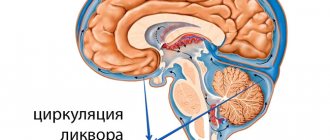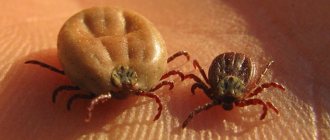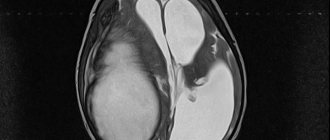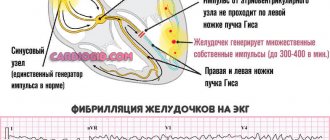The baby has just been born, and everything is no longer as colorful and fabulous as depicted in the pictures. Crying loudly, chin shaking, eyes rolling up. And the first thing parents do is show the baby to a specialist.
And in principle, the approach is correct, if not for one “but”. A specialist in our country cannot say that this will all go away on its own.
You came for a diagnosis, and not for the phrase that everything is fine with you and will pass with age. That’s why the doctor gives a popular definition for any unusual behavior in the baby – increased ICP.
How to determine whether a baby really has increased intracranial pressure (ICP), which symptoms are real, which are far-fetched, and how to treat it? And is it necessary to treat at all? Let's look into all the details of such a frightening diagnosis together!
What is ICP in a baby?
The pressure inside the skull is regulated with the help of cerebrospinal fluid - this is the medical name for spinal cord fluid. In infants, it significantly affects the further formation of the brain and the harmonious development of the whole organism. If this process is disrupted, intracranial pressure increases, which can negatively affect the physical and mental health of the newborn in the future.
Intracranial pressure in infants (symptoms of its increase can be expressed to varying degrees, depending on the severity of the pathology) normally ranges from 2 to 6 mm. rt. Art. Some children are born with an increase in it, then the indicators return to normal. But if the intracranial pressure in a newborn is consistently high, additional diagnosis of the disease is necessary.
Symptoms in older children
- Nausea, vomiting. As a result of irritation of the centers of the medulla oblongata. Vomiting does not bring relief, which distinguishes it from vomiting due to food poisoning.
- Children complain of pain behind the eyeballs. It occurs due to the pressure of the cerebrospinal fluid on the area behind the eye sockets.
- Children may report double vision, flashes, and streaks in front of their eyes. Occur due to irritation of the optic nerves.
- Severe headaches, the intensity of which increases in the evening and at night.
- Tearfulness, irritability, restless sleep.
More details in our article - Symptoms and treatment of increased intracranial pressure
Congenital and acquired causes of intracranial pressure in infants
Intracranial pressure in infants, the symptoms of which are described below, is divided into congenital and acquired. At birth, it increases if there were pathologies or disturbances in the mother’s normal parameters during pregnancy. Acquired increased intracranial pressure occurs after infections or injuries.
The main causes of increased intracranial pressure:
- Hereditary anomalies;
- Intrauterine infection;
- Taking medications during pregnancy;
- Chromosomal abnormalities;
- Prematurity;
- Heavy metal poisoning;
- Rapid fusion of the fontanelle and the bones of the skull;
- Severe toxicosis;
- Abnormalities of the placenta;
- Oxygen starvation in the baby or entanglement in the umbilical cord;
- Injuries during childbirth;
- Inflammation and infection of the brain;
- Hemorrhages;
- Neoplasms;
- Trauma in infancy.
Prevention
This pathology can be prevented in infants only by proper preparation for pregnancy. If the mother is healthy, did not abuse anything during the process of bearing a new life, and behaved correctly during the birth process, the likelihood of such a pathology in the baby is minimal.
Screening studies for genetic abnormalities during fetal growth and development should not be neglected. Of course, you should not drink alcoholic beverages, smoke or take drugs, or any medications during pregnancy.
In addition, it is important to pay attention to the baby’s health after birth. Walk more, eat well, do children's gymnastics. Protect your child from hypothermia and overheating, viruses, and get vaccinated in a timely manner.
In essence, the prevention of ICP comes down to preventing the pathologies of which this condition is a symptom. But it is important to understand that no dietary supplements, homeopathic remedies or any other magic pills will help. Only a healthy lifestyle and proper attention to the child will protect against the arrival of such a disaster in your home.
Signs of ICP in a baby
The following are signs of increased intracranial pressure:
- The head exceeds the age norm;
- The eyes may bulge;
- Constant continuous annoying crying;
- During sleep, the child's irises can be seen;
- The upper eyelids are not washed off;
- Stool disorders;
- Constant regurgitation;
- Decreased appetite;
- Refusal of breast milk;
- Moodiness;
- Sleep disorders;
- Swelling of veins on the head;
- The appearance of a fontanelle;
- Trembling of fingers and hands;
- Anxiety;
- Shaking the head in different directions;
- Lethargy;
- Changes in behavior when weather changes;
- Tilting the head back;
- Developmental delay compared to other children;
- Visual impairment - the child may behave like a blind person and not respond to external stimuli;
- The child does not respond to pranks and entertainment, is indifferent to games, and does not smile.
Pressure abnormalities can only be accurately determined in a medical facility.
Severe symptoms
Perhaps the main sign indicating this illness is the child’s restless behavior. The baby cannot sleep, cries constantly and even refuses to eat. Even water makes him sick.
In children aged several months, external symptoms of increased ICP can be noticed and identified.
They manifest themselves in changes in the child’s body parameters:
- the head is not proportionately large;
- the frontal part is enlarged;
- fontanel with signs of swelling;
- veins appear on the head;
- eyeballs are too downward;
- the baby has problems gaining weight and has a slow reaction time;
- some developmental deviations are observed;
- sometimes frequent regurgitation also indicates increased ICP.
As the child develops, the symptoms become more clear and pronounced. Having learned to speak, the baby himself will be able to say that he is experiencing pain, and it will become easier for parents to understand what kind of condition the child has.
Veins on the head
Violation of intracranial pressure in infants is accompanied by the fact that the veins on the head may stand out unnaturally and swell. But in some cases this is a variant of the norm. In newborn babies, the subcutaneous fat layer is not yet sufficiently developed, so veins will be visible on the head immediately after birth.
In most cases, this is not a sign of pathology and will decrease over time. But in combination with other symptoms, prominent veins on the head indicate increased intracranial pressure.
Why does blood pressure rise?
There are many factors that contribute to increased ICP levels. Newborns have more and more such problems every year. Hypertension is spreading among infants all over the planet. Let's consider the reasons for the increase in pressure.
Anomalies in the formation of the placenta , through which the fetus in the womb is supplied with micronutrients. Problems in the structure of the placenta or blood vessels cause problems with the veins. When the baby is born, he develops intracranial hypertension.
Birth injuries. Incorrectly chosen delivery tactics or sudden complications can cause a traumatic brain injury in a child. Such problems often cause damage to the meninges. When the ventricles or blood vessels are damaged, the child's hypertension becomes much worse.
Intrauterine infections . It is characterized by an increased danger in the 1st and 3rd trimester. Microorganisms entering the circulatory system penetrate the hematoplacental septum. When it enters a child's body, brain damage occurs. Sometimes postpartum hypertension occurs after this.
Injuries . When a child falls and hits his head, the meninges are damaged and the cervical vertebrae are injured. Emerging defects complicate the movement of cerebrospinal fluid. Tumors occur rarely, and when they develop, they put pressure on the ventricles. As a result, the outflow of cerebrospinal fluid worsens.
Bleeding . If the newborn's brain is injured, hemorrhages occur. These are congenital problems or a consequence of fragility of blood vessels.
Brain inflammation . Infectious meningitis causes problems with venous drainage, causing hypertension. All factors cause hypoxia. This condition is characterized by a lack of oxygen and an excess amount of carbon dioxide. As a result, problems with brain activity appear and adverse symptoms arise.
Big forehead
One of the signs of cerebral circulatory disorders is a large forehead that is larger than normal. It has a convex shape, and the skull hangs slightly over the back of the head.
Symptoms of increased intracranial pressure in infants are similar to hydrocephalus
Young mothers mistake this pathology for dropsy. Pediatricians claim that the causes of forehead protrusion are the congenital anatomical structure of the bones, hydrocephalus or rickets. Additional examination allows you to exclude pathology or prevent developmental disorders of the baby, if any.
Forecast and consequences
Early detection of hypertension syndrome in an infant allows one to avoid the development of severe complications of this process and the progression of the disease, the symptom of which is pathological hypertension. Long-term hypertension can lead to disruption of the baby’s neuropsychic development, visual disturbances, dysfunction of vital organs, and even the development of epileptic seizures. The extent of the consequences and their severity depend on the location of the pathological focus. Thus, with an increase in symptoms and the development of cerebral edema, the medulla oblongata is involved in the process, in which vital centers are located - respiratory and vasomotor. Clinically, this is manifested by respiratory failure and the inability of the circulatory system to ensure the normal functioning of other organs. The prognosis for the child is quite favorable if this syndrome is detected early, pathogenetic therapy is prescribed, and the doctor constantly monitors the condition of the little patient. The social and living conditions of his residence are essential for a child’s recovery.
Skull dehiscence
Unlike an adult, the skull bones of a newborn child are mobile. This is necessary in order to pass through the pelvic bones without damage during childbirth. In large children or newborns with a disproportionately large skull, the cranial sutures separate and this is normal.
Over time, the fontanel heals and the bones take their natural position. But if this does not happen, additional examination by a pediatrician is necessary. Possible intracranial pressure disorders or other pathologies.
How to determine intracranial pressure in a baby?
At home, you can determine the increase in pressure visually. If the skull is larger than it should be, and the fontanel does not heal, there is reason to suspect increased intracranial pressure.
An ophthalmological examination, ultrasound and brain tomography help to accurately determine it. Impaired muscle tone and reaction to stimuli are also indirect signs of increased pressure inside the child’s skull.
Ophthalmoscopic examination
With intracranial pressure, intraocular pressure also increases, which can be detected by an ophthalmologist. If it increases, visual disturbances occur, the eyeballs protrude from the orbits, pain occurs when pressing on the eyeball, or the blood vessels begin to turn red and burst.
An ophthalmologist’s conclusion about increased intraocular pressure is a reason to check intracranial pressure. Especially if there are signs of an increase in it in a newborn baby.
Visual diagnostic methods
These include:
- Head circumference measurement;
- The presence or absence of swollen veins, a non-overgrowing fontanel;
- Muscle tone study;
- General assessment of the condition or behavior of the infant.
At birth, a newborn’s head has a circumference of about 34 cm. With normal development, it increases by 1 cm per month and reaches 46 cm by one year. Sometimes the doctor changes individual parameters, depending on the size of the child. An enlargement of the head by more than 2 cm is a sign of pathology and a reason for additional examination.
If the fontanel does not heal by the age of one year, and the bones of the skull do not return to their normal position, this is a sign of increased intracranial pressure.
Restless behavior, sleep disturbances, hyperactivity and regurgitation are indirect symptoms of increased pressure inside the skull. If there are no other reasons, most likely this is the problem.
Impaired muscle tone is a sign of pathology. Together with pathological signs of increased intracranial pressure, an accurate diagnosis is made.
Redness of the eyes, pain when pressing on the eyeball and the inability to close the eyelids indicate possible problems with intracranial pressure.
If the forehead is too large, the head is disproportionately larger than normal, there are signs of developmental delay - slower reactions, anxiety, then this is a reason to be wary. Most likely, intracranial pressure will be higher than normal.
Lumbar puncture
Prescribed after meningococcal infections, encephalitis and inflammation of the meninges. If there is a suspicion of increased intracranial pressure, the doctor will refer you to donate cerebrospinal fluid for examination. A sample of the cerebrospinal fluid is taken through a special sterile needle and analyzed.
The study reveals hidden infections and the general state of the child’s immunity. The state of the protein fluid is assessed and intracranial pressure is determined. The method is prescribed by a pediatric neurologist or neurosurgeon.
Along with this study, a general blood test for leukocytes and neutrophils is prescribed. Based on their condition and correlation, latent infections and inflammatory diseases, which have become a possible cause of high intracranial pressure in a newborn, are determined.
MRI
Intracranial pressure in infants, the symptoms of which were discovered by the pediatrician and the child’s parents, is checked using MRI. Tomography is performed with a closed fontanel; pediatricians prescribe this study after a year, in some cases earlier.
Pediatric MRI is prescribed in rare cases, since this study requires a calm state of the newborn, and this is not always possible. Therefore, up to a year, computed tomography is prescribed only for severe pathologies or after infectious diseases, after which an increase in intracranial pressure is likely as a complication.
This type of study may have contraindications. Being in a closed space is in itself painful for a child, so it can not only negatively affect his psyche, but also give the wrong result under the influence of fear.
Therefore, MRI in childhood is prescribed extremely rarely and is replaced by computed tomography of the brain. During this study, the brain is exposed to X-rays, so it is not considered the safest and is prescribed only as a last resort.
Neurosonography
Another name for the research method is ultrasound examination of the brain. The most painless and frequently prescribed procedure with no contraindications.
Allows you to identify the abnormal structure of the skull, the size of the ventricles of the brain, changes in the structure of which can be the cause of high intracranial pressure.
Echoencephalography
An outdated diagnostic method used in extreme cases. This method is used only in rural clinics or small provincial towns. Using special wiring, the state of the brain vessels is examined by their pulsation.
This method does not allow making an accurate diagnosis - it only helps to determine possible negative changes in the structure of the brain and blood vessels.
In modern diagnostics, echoencephalography is not used, since the study does not always give an accurate result.
What can cause brain pathologies?
The main cause of ICP in infants is hydrocephalus, which occurs due to increased production of cerebrospinal fluid. As a result, excess fluid accumulates in various parts of the brain, disrupting the normal patency and absorption of cerebrospinal fluid.
Typically, hydrocephalus in the fetus begins to develop in the last months of a woman’s pregnancy. Symptoms of this congenital disease can be detected immediately after birth. If treatment is started in a timely manner, there is every chance that the child’s cranial pressure will soon return to normal.
There are cases when cranial pressure in an infant increases gradually, the reason for this may be:
- a genetic or chromosomal disorder that causes congenital neurological defects;
- very early birth, when the child’s cerebral cortex has not yet fully formed;
- difficult pregnancy with pathologies;
- intrauterine infectious disease transmitted to the child from the mother;
- birth injuries to the head or concussion.
Among the diseases accompanied by the development of ICP, the most common are:
- encephalopathy and hydrocephalus;
- neuroinfectious diseases (meningitis, encephalitis, etc.);
- severe disturbance of metabolic processes in the body, leading to diabetes mellitus and hypothyroidism;
- brain tumor.
How to treat ICP in an infant?
Intracranial pressure in infants, the symptoms of which have made it possible to accurately diagnose, is treated depending on its cause, since it is not a disease, but a symptom of pathology.
If the cause of intracranial pressure is oxygen starvation during childbirth, sedatives and water procedures are prescribed. Gradually, the consequences of a lack of oxygen are eliminated and intracranial pressure normalizes.
Actovigin and glycine are prescribed as auxiliary agents. Actovigin injections normalize intracranial pressure, and children's massage is prescribed as an additional treatment. It activates blood circulation, oxygen supply to the brain, helps normalize the development of the child and improve overall muscle tone.
If the accumulation of cerebrospinal fluid becomes dangerous, surgery is prescribed. The operation is performed under general anesthesia, a certain amount of cerebrospinal fluid is surgically removed and after this the indicators return to normal. If a tumor is present, surgery is also prescribed. By removing it surgically, the doctor normalizes intracranial pressure.
But surgical intervention is prescribed extremely rarely. Most often, drug treatment is sufficient. After completing the course, the doctor observes the child’s condition for some time and repeats the studies. And even if the diagnosis is removed, the child remains registered with a neurologist for a year or several years.
To normalize blood pressure, medications are prescribed:
- Magnesia;
- Glycine;
- Glycerol.
In the absence of pathologies, doctors advise lowering blood pressure by strengthening the baby’s overall endurance. Baths, baby massages, and walks in the fresh air help.
It is recommended to massage the child’s entire body to normalize blood pressure and avoid stagnation of blood or cerebrospinal fluid . In some children, the pressure inside the skull increases with colic, bowel movements, and weather changes, and this is the norm. With proper development, after a year, intracranial pressure no longer rises.
Treatment
The main goal of treatment is to stabilize the child’s condition to prevent possible complications.
Treatment is carried out by a pediatrician or pediatric neurologist. The specialist prescribes a number of diagnostic studies to confirm or refute this syndrome.
Treatment is divided into non-pharmacological and medicinal.
Non-drug treatment:
- diet therapy, which also involves temporary restriction of fluid intake;
- physiotherapeutic methods of treatment;
- baby massage to improve the drainage function of the lymphatic system;
- a neurosurgical operation is performed in the absence of the effect of conservative therapy, the risk of complications and visual dysfunction in the form of loss of visual fields;
- therapeutic physical culture (therapeutic physical education).
Drug therapy:
- dehydration therapy involves the use of diuretics - mannitol, furosemide;
- nootropics are necessary to improve cerebral circulation;
- Antibacterial therapy is carried out when an infectious process of a viral or bacterial nature is identified;
- neuroprotectors;
- antiemetic drugs are prescribed when vomiting and regurgitation occur;
- sedatives are necessary for restless and irritable behavior of the child, as well as for sleep disturbances.
The attending physician may also prescribe symptomatic therapy aimed at eliminating associated symptoms.
An indication for emergency hospitalization of a child in a hospital is a violation of his consciousness. In the infectious diseases department of the hospital, infectious and inflammatory diseases (meningitis) are treated and surgery is performed if indicated.
Signs of the effectiveness of the treatment are the following:
- disappearance of cerebral symptoms;
- relief of neurological symptoms;
- absence of complications - optic nerve atrophy, dysfunction of other systems (respiratory and cardiovascular).
Magnesia
Magnesium sulfate affects the state of intracranial pressure. Prescribed by injection, it has a sedative, antispasmodic, sedative and anticonvulsant effect on the body.
It is used intramuscularly or intravenously. Intracranial pressure decreases within an hour, but this drug can cause diarrhea, headache, and a sharp decrease in blood pressure.
In some cases, the drug causes drowsiness. But if after the injections there are convulsions, anxiety and a clear deterioration in the general well-being of the newborn, it is replaced with an analogue.
Magnesia dilates blood vessels and lowers high intracranial pressure, but it is contraindicated for children with low blood pressure.
Evgeny Komarovsky opposes the use of this drug. In his opinion, the administration of magnesia is ineffective or can traumatize the child’s psyche, since the drug is very painful for him.
But most pediatricians prescribe magnesia intramuscularly or intravenously, as it calms the nervous system, relieves overexcitation and normalizes blood pressure. In some cases, the drug can cause depression of the respiratory center, so if the lips turn blue, shortness of breath and breathing problems occur in infants, the drug should be discontinued.
Diagnosis of the disease in children
The need and type of treatment for the baby is prescribed only after a detailed medical examination of the signs and causes of the disease.
If you encounter one of the symptoms listed above, be sure to consult a neurologist!
The research proceeds as follows:
- Oral diagnosis (clarification of prenatal, birth and postpartum features of the baby’s life course).
- Superficial examination (head measurement, checking reactions, muscle tone...).
- Carrying out a procedure to measure intracranial pressure (neurosonography - ultrasound examination of the head cavity through an unopened fontanel).
- An encephalogram and tomography can also be performed. These methods not only allow you to measure intracranial pressure, but also assess the condition of the ventricles of the brain.
- Using puncture of the ventricles of the brain and spinal puncture, you can find out the exact indicators of the baby’s ICP. These 2 procedures can be prescribed if other research methods are ineffective or insufficiently informative.
If the problem is nevertheless diagnosed, the causes of ICP are simultaneously determined and a course of treatment is selected, taking into account age and individual characteristics.
Glycerol
A drug for lowering blood pressure based on glycerin. It removes excess fluid, preventing it from stagnating in the body. It has a mild diuretic effect, does not cause allergies and reduces the volume of cerebrospinal fluid.
Glycerol lowers intraocular pressure. The drug has a calming effect on the body, but can cause bowel problems. Therefore, it is prescribed by pediatricians in extreme cases, but, unlike analogues, Glycerol does not have pronounced side effects and does not provoke lethargy, apathy and drowsiness. This drug acts slowly, but stabilizes intracranial pressure and is not addictive.
| Glycerol | The cost in Moscow and St. Petersburg is 18 rubles. | Price in the regions – 13 rubles. |
| Magnesia | 14 rub. | 18 rub. |
Prognosis, complications
In most cases, in the absence of pathologies, intracranial pressure returns to normal on its own or develops into vegetative-vascular dystonia, which can be successfully treated with the right diet and a reasonable alternation of work and rest.
A salt-free diet or limiting the use of salt and spices helps normalize blood pressure. With increased intracranial pressure, it is important to control the child’s weight and prevent obesity.
High blood pressure in itself is not a disease; it does not affect the development of the child in any way, unless there are no other pathologies in the body. The main treatment should be directed at them, after which the pressure indicators themselves will return to normal.
Intracranial pressure in infants goes away on its own by the age of one year. But if symptoms remain after a year, it is recommended to resume the examination and take appropriate measures.
Article design: Mila Friedan
Video “Komarovsky about intracranial pressure”
Filmed by the channel School of Doctor Komarovsky.
Do you have any questions? Specialists and readers of the KROHABABY website will help you ask a question
Was this article helpful?
Thank you for your opinion!
The article was useful. Please share the information with your friends.
Yes (100.00%)
No
X
Please write what is wrong and leave recommendations on the article
Cancel reply
Rate the benefit of the article: Rate the author ( 1 vote(s), average: 5.00 out of 5)
Discuss the article:











